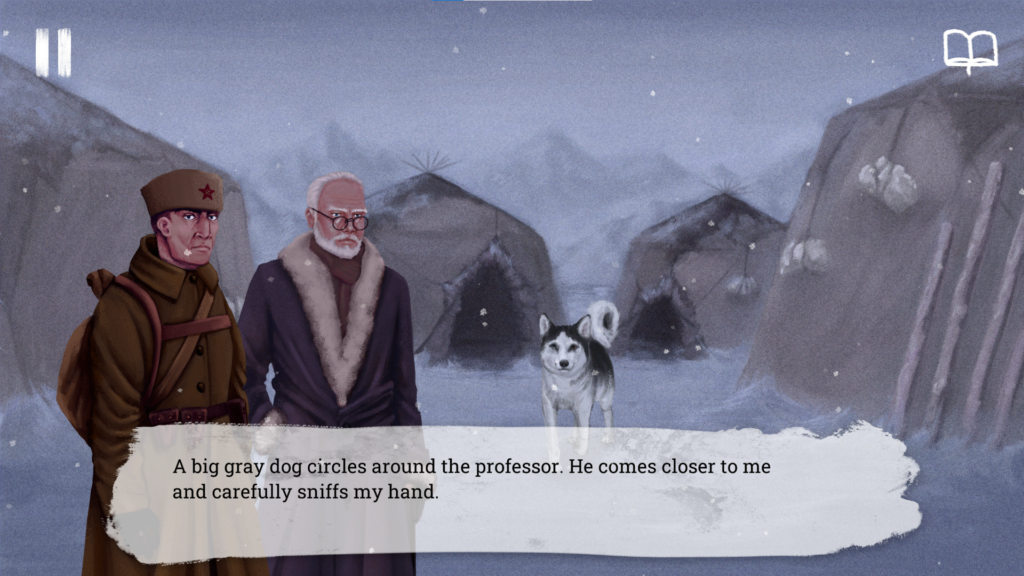It is commonly thought that, gamers don't like reading long texts. This is only half true. It's not the length itself, but the information the text conveys.
I will use excerpts from my visual novel Last Threshold as an example to analyze the text content. While working on the game, we wanted the dialogues and descriptions to be expressive. We didn’t want to waffle. We eliminated the terms, “someone’s,” “some,” ” any,” and replaced them with definite phrases. Just as important as eliminating unnecessary “embellishments” was determining what information the player should get at the beginning. Here is an excerpt from one of the first versions of the game’s opening:
Vladislav showed me photos of the ruins exposed by the earthquake. He got them from a reporter friend, who is waiting for us in the village along with our engineer. Similar structures were described by my father after his return from exile.(…)
Nikolai Morozov’s sleigh emerges from behind the snow drifts. The arrogant military man introduced himself to me earlier as a friend of Antos. It is him, who we owe the acquisition of permission to organize the expedition. Apparently, the veteran has friends of high rank. To me, he is more of a servant type, sent to keep an eye on us.
Info-Dump, or in the trap of excess
The overabundance of unnecessary information imidiately strikes the eye. The player is overwhelmed with facts. Reporter, engineer, expedition, Nikolai? What is the most important thing here, what to focus on? Such an information overload is called info-dump. It acts like a hindrance from entering the game world for many players. Info-dumps are encountered not only in visual novels, but also in RPGs, for example, when the player is bombarded with stories of families, places and fourth-plane characters. This kind of information can sometimes build atmosphere, but it can also be discouraging. Ill-conceived and overly detailed world-building will interfere with enjoyment of the game. We were fully aware of a similar danger. In order to avoid the effect of overload, we decided to rewrite the entire initial section.

With this modification, we partially solved the problem of exposition. We did not give up any information, but only skillfully wove it into later dialogues. In starting the game with the diary entry, we decided on a quite risky narrative procedure. We omitted the previously planned exposition passages, which were supposed to present the main character even before the events in Siberia. As Lead Writer, I was worried that adding additional panels before the journal entry would make the beginning of the game too stretched out and boring. But were my fears justified?
Visual Novels are not action games. As a genre, they do not require excessive rushing. Therefore, if there are plot-reasoned purpose for a longer exposition, you should not be afraid of it. It is important to distribute information wisely, and of course, not to overdo it. Five to ten minutes of additional exposition is not the same as suddenly extending the beginning of the game by half an hour!
The above-mentioned dosage of information should be understood in two ways. It’s not just about the sparing use of information, but also about their sequencing in the text box.
How much text to show the player at once in the text box? Two, three, or maybe four lines? This seemingly trivial problem affects the game experience, as well as the process of writing visual novels.
Quality = quantity
Each line in the text box is assigned a certain number of characters. Scriptwriter’s task is to include a single thought or event within the scope he or she has been assigned. Take the example of the description from Last Threshold:
Text box: A big gray dog circles around the professor. He comes closer to me and carefully sniffs my hand. I bend down to pet the animal. It tries to get into one of my coat’s pockets, where I kept the leftover beef jerky
Although this text notation is correct, it is not the most convenient one. Here we are dealing with two events and points of view. One focuses on the dog. The other on the interaction between the dog and the protagonist. In this case, it is useful to separate the text into two displayed fragments. This kind of procedure can be referred to as intra-textual editing:


Structured this way, the text contains a slight time jump. From the moment the dog approaches until it is stroked, a small stretch of time has passed. In a movie, such a situation would probably be edited appropriately with a change of perspective. In a visual novel, we can mark such treatments with elegant editing. The same can be done for longer sections of dialogue spoken by the same character:
Text Box: A few years after Charles’ death, I accidentally came across a copy of the Necronomicon. A very rare find.
Text Box: The symbols with which it was written looked identical to those in your father’s sketches.
Of course, similar procedures also occur in other game genres. Almost every dialogue can be “shredded” in several different ways. Proper intra-textual editing can be achieved by following actions:
- Well thought out content. The scriptwriters know why they included the information
and understand its function. - Avoidance of overly long and lengthy statements. (Except for single situations motivated by the plot or the style of the characters.).
- Editing statements at the end, not in the middle of a sentence. Splitting long sentences into shorter ones. As a last resort rewrite parts of the dialogue
completely.
